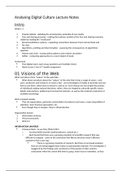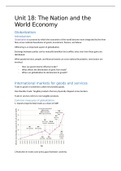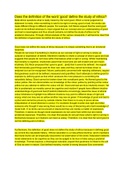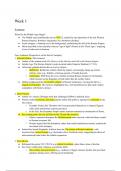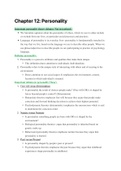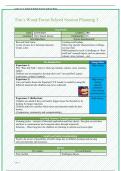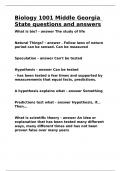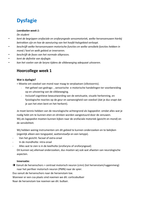IF Summary – Lecture 6
Learning Goals
1. Describe the key stylized facts about the multinational firm.
2. Review the classic trade theory to explain the conventional inter-industry trade.
3. Review the modern trade theory to explain which firms become MNCs and inter-
industry trade.
4. Understand the micro foundations of exporting and two main types of multinational
activity.
LG1: Describe the 6 key stylized facts about the multinational firm
Motivation:
- Globalization is the increase in international flows of…
1. Goods and services
2. Capital
3. Information/Ideas
4. People
- International trade has grown rapidly in the last couple of decades!
- Puzzle of home bias in trade
o Home bias: People have a preference for home goods
▪ ➔ Goods market far more segmented than theory predicts
o Gravity Model: Value of trade between any pair of countries diminishes with
distance
▪ Distance also refers to cultural distance!
▪ May be explained by transportation costs
Fact 1: MNCs are large!
Economic importance of MNCs:
- Parents and affiliates of MNCs s are primarily located in developed countries
- Affiliates are better represented in developing countries than are parents
Fact 2: Strong national identity and forces of gravity
Geographic structure of global production within MNCs:
- Most value-added/economic activity is in the parent country
- Gravity matters for location of affiliates
o Countries close to the parent!
Fact 3: MNCs “select” certain industries
Cross-industry variation in the importance of MNCs:
- MNCs more active in capital and R&D intensive industries
Fact 4: MNCs are top of the order for firm productivity
Within-industry differences between MNCs and other firms:
- Relatively few MNCs, but they are larger, more productive
and more export orientated than domestic firms!
o Even among MNCs, a few very large players
separate themselves from exponentially increasing
smaller MNCs
- Graphs shows firm productivity (x) vs. probability (y) for
domestic firm (black line) and foreign owned firm (red line)
4 years after acquisition/non-acquisition ➔ Shows higher
productivity for red line!
, Fact 5: HQs design, affiliates sell
“Division of labor” within MNCs
- Within MNCs, headquarters are specialized in R&D
- Affiliates specialize in serving foreign markets rather than exporting back to parent
country
Fact 6: MNCs are choosy to enter a market and selecting local
firms to acquire
The mode of entry of the MNCs
- Cross-border M&As account for large part of FDI
- Affiliates acquired through a cross-border acquisition
tend to be more productive than average in the target
country
- More productive firms enter foreign market through
green field investments (Build a plant from scratch)
- Graph: Dotted lines shows initial productivity of firms
that will be acquired in the next 4 years vs productivity
of domestic firms that will not be acquired (black line)
LG2: Review the classic trade theory to explain the conventional inter-industry trade.
Selling goods & services between countries is mutually beneficial, even for least productive
countries. Classic theory focuses on inter-industry trade (exchange of different goods)
through comp. advantage:
Comparative advantage:
- Assumption: Markets are competitive; constant returns to scale; Countries face
budget constraint with available resources.
-
- US more productive in absolute terms, but in relative terms more productive in cloth
- ➔ Specializing is more efficient due to large-scale of production
- 2 Major reasons contribute to comparative advantage
o Technology driven (Differences in labor productivity) – David Ricardo
o Relative factor abundance (supplies of capital, labor and land and intensity of
their use in the production)
▪ ➔ Comp. advantage holds no matter what causes it!
Classic trade theory predicts that countries trade…
- Proximity: The closer countries are, the more they trade (less costs)
- Natural resources/climate determine why some countries export
Learning Goals
1. Describe the key stylized facts about the multinational firm.
2. Review the classic trade theory to explain the conventional inter-industry trade.
3. Review the modern trade theory to explain which firms become MNCs and inter-
industry trade.
4. Understand the micro foundations of exporting and two main types of multinational
activity.
LG1: Describe the 6 key stylized facts about the multinational firm
Motivation:
- Globalization is the increase in international flows of…
1. Goods and services
2. Capital
3. Information/Ideas
4. People
- International trade has grown rapidly in the last couple of decades!
- Puzzle of home bias in trade
o Home bias: People have a preference for home goods
▪ ➔ Goods market far more segmented than theory predicts
o Gravity Model: Value of trade between any pair of countries diminishes with
distance
▪ Distance also refers to cultural distance!
▪ May be explained by transportation costs
Fact 1: MNCs are large!
Economic importance of MNCs:
- Parents and affiliates of MNCs s are primarily located in developed countries
- Affiliates are better represented in developing countries than are parents
Fact 2: Strong national identity and forces of gravity
Geographic structure of global production within MNCs:
- Most value-added/economic activity is in the parent country
- Gravity matters for location of affiliates
o Countries close to the parent!
Fact 3: MNCs “select” certain industries
Cross-industry variation in the importance of MNCs:
- MNCs more active in capital and R&D intensive industries
Fact 4: MNCs are top of the order for firm productivity
Within-industry differences between MNCs and other firms:
- Relatively few MNCs, but they are larger, more productive
and more export orientated than domestic firms!
o Even among MNCs, a few very large players
separate themselves from exponentially increasing
smaller MNCs
- Graphs shows firm productivity (x) vs. probability (y) for
domestic firm (black line) and foreign owned firm (red line)
4 years after acquisition/non-acquisition ➔ Shows higher
productivity for red line!
, Fact 5: HQs design, affiliates sell
“Division of labor” within MNCs
- Within MNCs, headquarters are specialized in R&D
- Affiliates specialize in serving foreign markets rather than exporting back to parent
country
Fact 6: MNCs are choosy to enter a market and selecting local
firms to acquire
The mode of entry of the MNCs
- Cross-border M&As account for large part of FDI
- Affiliates acquired through a cross-border acquisition
tend to be more productive than average in the target
country
- More productive firms enter foreign market through
green field investments (Build a plant from scratch)
- Graph: Dotted lines shows initial productivity of firms
that will be acquired in the next 4 years vs productivity
of domestic firms that will not be acquired (black line)
LG2: Review the classic trade theory to explain the conventional inter-industry trade.
Selling goods & services between countries is mutually beneficial, even for least productive
countries. Classic theory focuses on inter-industry trade (exchange of different goods)
through comp. advantage:
Comparative advantage:
- Assumption: Markets are competitive; constant returns to scale; Countries face
budget constraint with available resources.
-
- US more productive in absolute terms, but in relative terms more productive in cloth
- ➔ Specializing is more efficient due to large-scale of production
- 2 Major reasons contribute to comparative advantage
o Technology driven (Differences in labor productivity) – David Ricardo
o Relative factor abundance (supplies of capital, labor and land and intensity of
their use in the production)
▪ ➔ Comp. advantage holds no matter what causes it!
Classic trade theory predicts that countries trade…
- Proximity: The closer countries are, the more they trade (less costs)
- Natural resources/climate determine why some countries export


